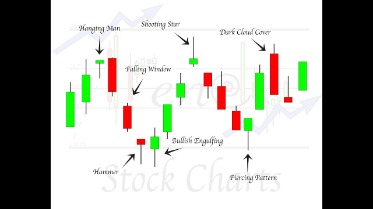
Candlestick charts show that emotion by visually representing the size of price moves with different colors. Traders use the candlesticks to make trading decisions based on regularly occurring patterns that help forecast the short-term direction of the price. The Dark Cloud Cover is a bearish reversal pattern that indicates a possible trend reversal in the market.

This cheat sheet shows you how to read the data that makes up a candlestick chart, figure out how to analyze a candlestick chart, and identify some common candlestick patterns. Candlestick formations and price patterns are used by traders as entry and exit points in the market. Forex candlesticks individually form candle formations, like the hanging man, hammer, shooting star, and more. Forex candlestick charts also form various price patterns like triangles, wedges, and head and shoulders patterns. All currency traders should be knowledgeable of forex candlesticks and what they indicate.
Candlestick Patterns For Beginners: 10 Patterns To Know
A bearish harami cross occurs in an uptrend, where an up candle is followed by a doji—the session where the candlestick has a virtually equal open and close. A bearish harami is a small black or red real body completely inside the previous day’s white or green real body. This is not so much a pattern to act on, but it could be one to watch.
The term for a stock with price action moving sideways is consolidating. Consolidating happens when the price of a stock stays between two price levels and moves sideways. The stock shown above consolidated for three months between $67 and $73. When a stock candlesticks for dummies is in an uptrend, more hollow candles are present. When a break in a trend line occurs, you may experience heavy selling. On most charts, if you can draw a multi-month trend line, the candle that closes below the trend line is usually a big filled candle.
Bullish Candlestick
Just above and below the real body are often seen the vertical lines called shadows (sometimes referred to as wicks). These two patterns are common examples of bullish three-day trend continuation patterns. These patterns are common and reliable examples of bullish two-day trend continuation patterns in an uptrend. The gravestone doji, on the other hand, appears like an “inverse T”. The upper wick should be long, and this represents a rejection of higher prices. Despite buying activities, price eventually closed near or at the open, at the low of the candle.
- A bullish harami cross occurs in a downtrend, where a down candle is followed by a doji.
- Stay tuned to the next parts of the series as we adopt a systematic approach in generating a step-by-step beginner’s guide.
- This type of candlestick represents a price increase over the period in question.
- StockCharts.com runs a scan every day looking for hammer candlesticks like the one described earlier and various other candlestick patterns.
It is a bearish signal that the market is going to continue in a downward trend. The Piercing Line pattern is a bullish reversal pattern that occurs after a downtrend and suggests a possible trend reversal. This pattern is characterized by two candlesticks, where the first one is bearish, and the second one is bullish. The second candlestick opens below the previous one’s low but then closes above the midpoint of the previous one, indicating a potential shift in market sentiment. In this case, the inverse hammer is actually a bullish pattern.
Why forex traders tend to use candlestick charts rather than traditional charts
A bullish harami cross occurs in a downtrend, where a down candle is followed by a doji. The Tweezer Tops and Bottoms pattern is a reversal pattern that typically indicates the end of a trend. This pattern is characterized by two or more candlesticks with identical highs (Tweezer Tops) or lows (Tweezer Bottoms), indicating a battle between the bulls and bears. Traders could take advantage of the shooting star candle by executing a short trade after the shooting star candle has closed. Traders could then place a stop loss above the shooting star candle and target a previous support level or a price that ensures a positive risk-reward ratio.
Fire and Ice: Marc Swanson at Mass MoCA and Thomas Cole National Historic Site – ARTnews
Fire and Ice: Marc Swanson at Mass MoCA and Thomas Cole National Historic Site.
Posted: Thu, 15 Dec 2022 08:00:00 GMT [source]
A hammer candle will have a long lower candlewick and a small body in the upper part of the candle. Hammers often show up during bearish trends and suggest that the price might soon reverse to the upside. A bearish candlestick forms when the price opens at a certain level and closes at a lower price. The default color of the bearish Japanese candle is red, but black is also popular. A bullish candlestick forms when the price opens at a certain level and closes at a higher price.
How Do You Interpret CandleSticks?
The small real body can be either black or white (red or green). The last candle closes deep into the real body of the candle two days prior. The pattern shows a stalling of the buyers and then the sellers taking control. The hammer candle formation is essentially the shootings stars opposite. It is a bullish reversal candle that signals that the bulls are starting to outweigh the bears.

A hammer would be used by traders as a long entry into the market or a short exit. Pairing two or more candles can be a little more valuable to confirm a pattern within a trending market. The first candle sets a bullish or bearish expectation for the next day, and the next day, investors watch to see whether the move based on the directional bias starts to happen. If it does, they investigate buying the stock on that basis and go through a process to decide. It covers the latest investing technology, cryptocurrency, and today’s somewhat-less-predictable market environment.
Copy My No-Brainer Trading Strategy
We can largely categorize candlestick patterns into (1) bullish, (2) bearish, and (3) continuation patterns. Now that we’ve covered the candlestick basics, let’s get into some of the easier-to-digest patterns. Each candlestick shows the opening, closing, high, and low price of a given period. Candlestick patterns offer traders valuable information at a glance, making it possible to identify certain chart patterns that may signal market trends and opportunities. A shooting star candle formation, like the hang man, is a bearish reversal candle that consists of a wick that is at least half of the candle length. The long wick shows that the sellers are outweighing the buyers.
Barbara Rockefeller is an international economist and forecaster who specializes in foreign exchange. A pioneer in technical analysis, she also led the way in combining technical https://g-markets.net/ and fundamental analysis. Barbara publishes daily reports using both techniques for central banks, professional fund managers, corporate hedgers, and individual traders.
Crew believes there are three key aspects to successful candlestick reading. This image will give you a better idea of the hammer candle family. The green arrows represent moves higher while the red arrows represent price declines. As Japanese rice traders discovered centuries ago, traders’ emotions have a major impact on that asset’s movement. Candlesticks help traders to gauge the emotions behind an asset’s price movements, believing that specific patterns indicate where the asset’s price might be headed. The lower wick should also be long, and this overall represents a rejection of lower prices as the session not only opened, but maintained its close at the top.
While the high and low is clearly indicated by the top and bottom of the wicks, the body will determine the open and close. It’s one of my favourite topics because there’s a levelling up to it. In the beginning, as most of us probably do, I started off by plain memorizing these patterns. Greg Schnell, CMT, MFTA, specializes in intermarket and commodities analysis for StockCharts.com. He contributes market analysis commentary to several blogs that garner between 5,000 and 10,000 readers weekly. To learn more about Crew’s method of trading backed by mathematical probability, you can check out his one core program.
This pattern is characterized by two candlesticks, where the first one is bullish, and the second is bearish. This shape of candle is a bullish candlestick called a hammer and is often seen at the bottom of a countertrend move. This is exactly what you would look for to end a downward move. When March 3 had similar price action (another hammer) and closed higher, this was very strong price action. They consist of a random candle and another bigger candle that fully encompasses or engulfs the price action contained within the first. It is identified by the last candle in the pattern opening below the previous day’s small real body.
Investigating individual candles
If it is followed by another up day, more upside could be forthcoming. A bearish engulfing pattern develops in an uptrend when sellers outnumber buyers. This action is reflected by a long red (black) real body engulfing a small green (white) real body. The pattern indicates that sellers are back in control and that the price could continue to decline. Do note that candlestick patterns should NOT be used in isolation.
